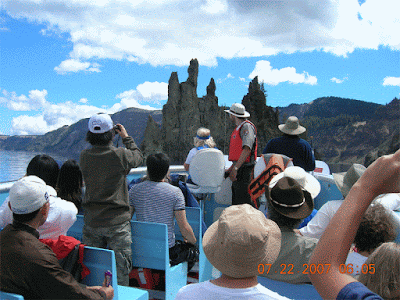Ross having presented his book The Raven and The Crayfish, which is inspired by Klamath legends.
Photo by Ranger Dave Harrison, used with permission.
The Crater Lake Trust hosted a special Family Fun Day on September 25th, 2010, which featured drummers, dancers, and storytellers from the Klamath tribe. It took place at the rim of Crater Lake.
The Trust hailed the NPS to recruit a Ranger to give a short presentation on the lake's geology and scientific significance, to complement the Klamath perspective. By the luck of schedule, that honor was assigned to me. I welcomed the opportunity to meet the first denizens of the Crater Lake region, and to share with them my Raven and Crayfish, which is so inspired by their stories. (I have met Klamath folks a few times before and listened to their perspective, but have never been brave enough to share my artistic interpretations with them... until now.)
I introduced myself to the public as follows....
“Hello I'm Ranger Ross, and before I begin my talk I must say that I am honored to have members of the Klamath tribe here. They are the true discoverers of Crater Lake, and the first people to inhabit this area. Although their perception of Crater Lake and that of most members of the National Park Service may not be the same in every detail, there is an underlying theme in common. Both parties see Crater Lake as a very special place. I would even go so far as to say that we, like the Klamath, see Crater Lake as a sacred place. I have long been fascinated by the Klamath stories about this landscape, just as much as I am with its geology and biology. I share their stories with visitors wherever I can. I have even drawn illustrations to their stories. I even wrote a book, my story about Crater Lake, which borrows elements from some of theirs. Ordinarily, when I do my presentation about the origins of Crater Lake, I give the Klamath perspective as well as the geology. But today, since the Klamath people are here to speak for themselves, I will omit the former. And without further ado, I present the origin of Crater Lake, according to geologists....”
I told the tale of how Mt Mazama became Crater Lake, and then turned things over to the Klamath. Lahoma Schonchin commented on the special significance of Crater Lake to the Klamath tribe, and introduced the performers. Then commenced the drumming and dancing. The ages of the Klamath people involved in the festivities ranged from three to senior citizens. The dancers wore their traditional regalia.
During the intermission of the dancing and drumming, Lynn Schonchin, a senior member of the tribe and father of Lahoma, took the stage and noted that he appreciated my presentation and it was interesting, but that he would tell the real story of how Crater Lake formed. His story was a version of “Coyote in Love with a Star.” He also commented on the sacredness of Crater Lake's water, and his people's traditions of drinking it for strength.
I have not yet heard any two Klamath people tell exactly the same story about the formation of Crater Lake. My favorite Klamath legend is “The Origin of Crater Lake” as it appears in Indian Legends of the Pacific Northwest by Ella Clark. This story was originally recounted by the Klamath Chief Lalek to the young white soldier Willam Colvig in 1865. It tells of the battle of the ages between the Chief of the Below World and the Chief of the Above World... and has AMAZING parallels to the geologic explanation for how Crater Lake formed. Not all Klamath stories are as close to the geology, but most have one notable thing in common... they describe a high mountain, which collapsed into the ground to create a gaping hole, which filled with water to become Crater Lake. Geologists long debated whether Mt Mazama blew apart or fell into the ground, and finally concluded that the mountain “fell in”--just as in the legends.
After the ceremonies, I presented one of my Raven and Crayfish to the Klamath folks. They were enthusiastic to receive it. I shall find out if they have any especial comments.
Notably, my book now has an ISBN number. It is 978-0-615-38888-5




